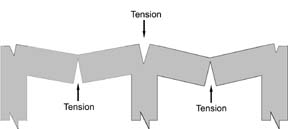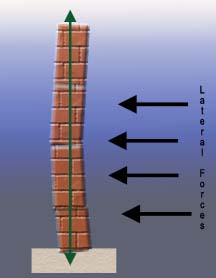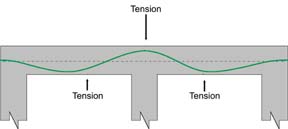|
|
|
|
|
|
|
|
|
|||
|
|
|
|
||||||||
|
Introduction Post-tensioning is a method of producing prestressed concrete, masonry and other structural elements. The term prestressing is used to describe the process of introducing internal forces (or stress) into a concrete or masonry element during the construction process in order to counteract the external loads that will be applied when the structure is put into use (known as service loads). These internal forces are applied by tensioning high strength steel, which can be done either before or after the concrete is actually placed. When the steel is tensioned before concrete placement the process is called pre-tensioning. When the steel is tensioned after concrete placement the process is called post-tensioning. The advantages of utilizing prestressed concrete and masonry have long been recognized by designers. When a designer wants to take advantage of those benefits, they must determine whether the structure is to be constructed using the pre-tension method or the post-tension method. Pre-tensioning is generally accomplished at a manufacturing facility where concrete members are constructed in special casting beds with steel bulkheads that hold the steel in place while tension is applied. Concrete is then placed around the pre-tensioned steel and allowed to harden. The steel is then cut loose from the bulkheads and the entire precast concrete member is transported to the project site for assembly. This process may be limited to the use of standard shapes, and sizes that can be easily transported. Post-tensioning is done at a project site and requires little to no modifications of the same forming system that would be used to construct non-prestressed concrete. The systems used to post-tension concrete and masonry consist of prestressing steel that is housed inside a duct or sheath, and allow the prestressing steel to be placed inside the typical job site formwork at the same time the rebar and other reinforcing is placed. Concrete is placed in a typical manner and allowed to reach a predetermined strength before the steel is tensioned. Since the prestressing steel is housed in the sheathing or duct, it will be free to move inside the concrete during the tensioning operation, and since the steel is tensioned after concrete placement, the tensioning is done against the hardened concrete instead of relying on large steel bulkheads. Using the post-tensioning method of prestressing enables a builder to get all the advantages of prestressed concrete or masonry while still enabling the freedom to construct the member (slab, wall, column, etc,) on the job site in almost any shape or configuration imaginable. What Does Post-Tensioning do to Concrete and Masonry?
When a concrete or masonry element is prestressed, it means that the steel is being tensioned, while the concrete or masonry is being compressed. Compression is a force that squeezes or crushes and tension is a force that pulls something apart. As building materials, concrete and masonry are very strong in compression, but they are relatively weak in tension. Steel, on the other hand, is very strong in tension. Putting the concrete or masonry into compression and the steel into tension before any substantial service loads are applied puts both of these building materials into their strongest states. The result is a stronger concrete or masonry member that is being actively compressed and has more capacity to resist tensile forces. One of the things that happens to a concrete floor, or a masonry wall, is
that they are subjected to forces that cause them to flex and bend. Examples of
this include slabs on ground where the edges of the slab are forced upward by
swelling soils, elevated concrete slabs where gravity and other applied loads
pull down on the slab in between supports, and walls that might be Adding post-tensioned reinforcing combines the action of reinforcing the tension zones with the advantages of compressing the concrete or masonry structure. Additional benefits are obtained when the post-tensioned reinforcing is installed in a draped profile instead of running in a straight line. A typical draped profile in an elevated concrete slab would route the post-tensioned reinforcing through a high point over the slabs supports, and through a low point in between those supports. Now optimum efficiency is obtained because the post-tensioned reinforcing is located in the tension zones, the concrete is being compressed, and the post-tensioned reinforcing is creating an uplift force in the middle of the spans where it is needed the most.
Source: PTConcrete.com
|
||||||||||
|
Home
| Company |
Products |
Services
| Support |
News |
Contact
Us © Copyright 2008 SPECIALTY STEEL rebar & post tension foundations |
||||||||||



 subjected
to lateral forces from wind or seismic activity. This bending creates high
tensile forces that can cause the concrete and masonry to crack. This is where
the use of reinforcing is applied. Since steel has a high capacity to resist
tensile forces, it can be embedded in the concrete at the
subjected
to lateral forces from wind or seismic activity. This bending creates high
tensile forces that can cause the concrete and masonry to crack. This is where
the use of reinforcing is applied. Since steel has a high capacity to resist
tensile forces, it can be embedded in the concrete at the